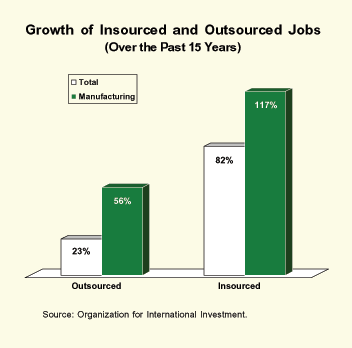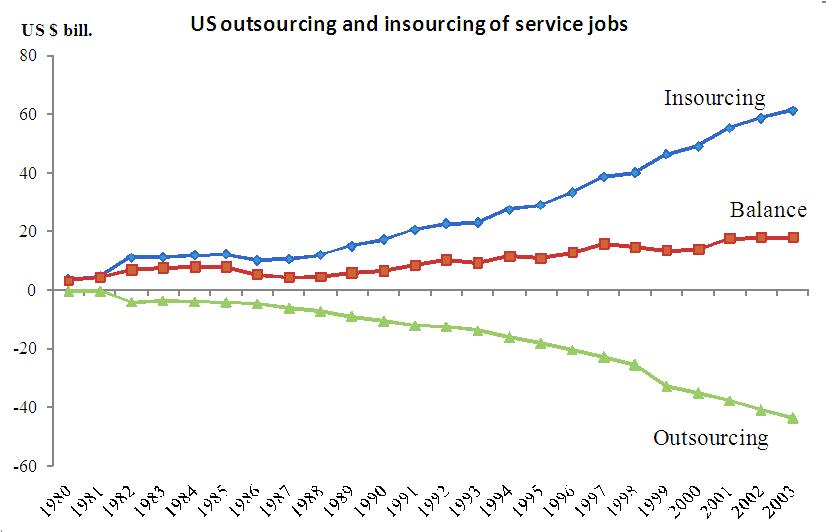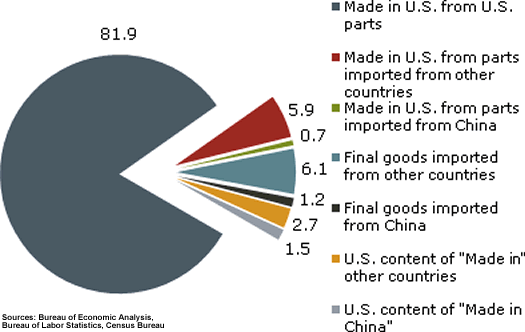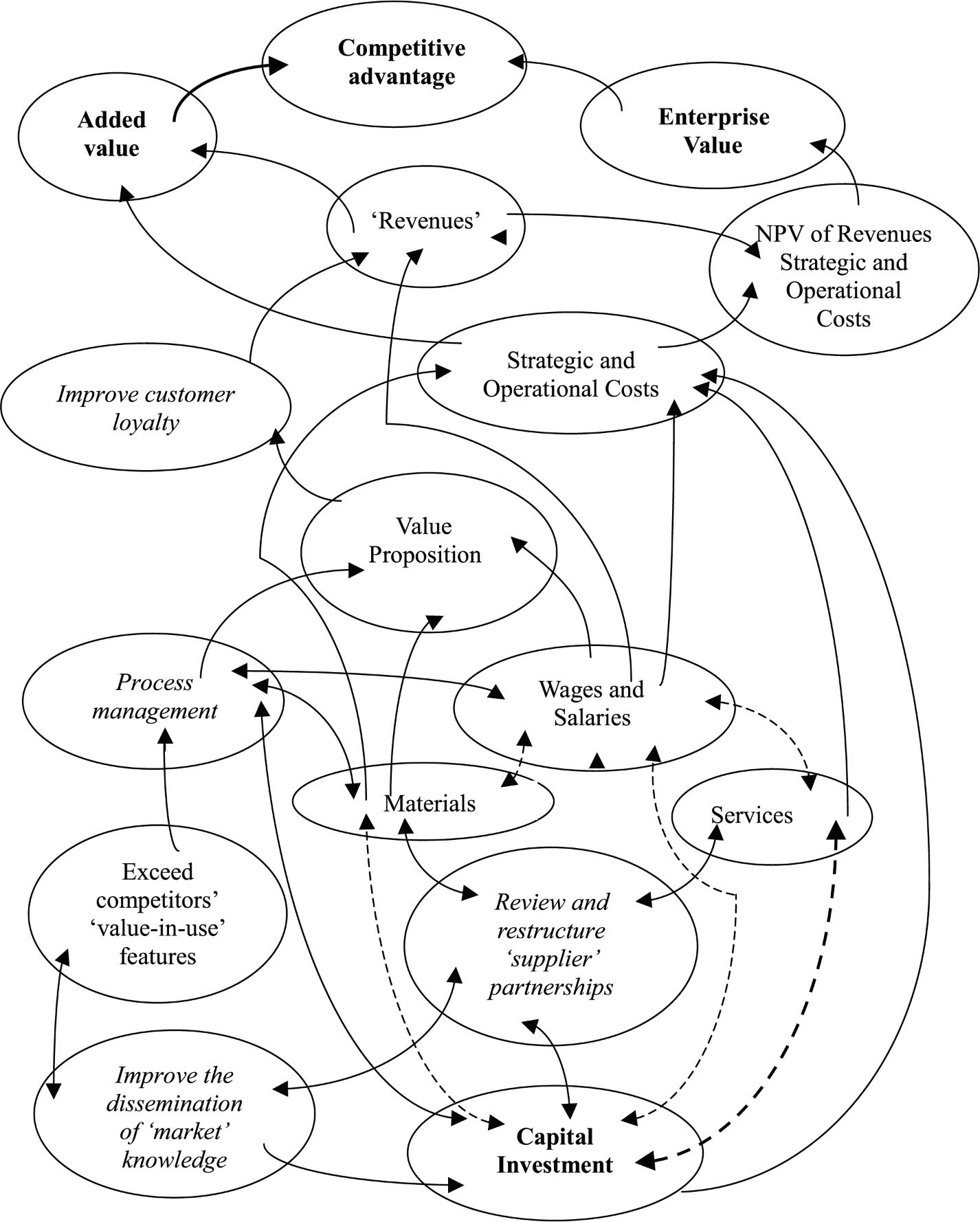Executive summary
In the business environment today, making decisions on an effective strategic sourcing method to adopt has become one of the key supply chain management challenges that managers are faced with as they seek better sourcing methods which favor them against intense global competition, short product life cycles and increasingly demanding customers.
In strategic sourcing, the decision to adopt in-sourcing, near-shoring or on-shoring plays an important role in enhancing the performance of an organization. When a manager in an organization decides to adopt a framework for sourcing, what will determine the concept to be used are the advantages or gains a business intends to make.
Studies point out that increased effectiveness and efficiency in a business is a factor that has a close relationship with cost. In-sourcing, on-shoring and near-shoring decisions have been identified as important key drivers of long-term approach towards saving current cost challenges on supply functions facing businesses.
As such, owners of business with complex products and high changing demands must ensure that they decide on sourcing strategies that do not interfere with their business’ total output. In terms of hiring workers, the decisions to in-source are advantageous in saving cost as employees can be hired via intern practices with other local business organizations, and mentoring activities for newly hired employees can be done internally.
In-sourcing decisions allow managers to standardize their local systems and tools by effectively and efficiently using their local stuff saving cost of hiring multiple specialists from elsewhere to perform roles. From a theoretical perspective, the effective operations of a business rely on decisions to adopt effective sourcing strategies to foster gaining of competitive advantage.
Flexibility and capacity have become some of the key benefits that businesses which have adopted in-sourcing, on-shoring and near-shoring are enjoying. Research has shown that many business supply functions for companies that are outsourcing and off-shoring are susceptible to threats, dangers and loses.
Analysts point out that the new concepts of sourcing strategies that businesses have adopted today have cushioned them from technicalities presented by outsourcing and off-shoring. Effective and efficient service improvement has become one of the key factors that have caused most companies that were using the contemporary outsourcing and off-shoring strategies to decide on in-sourcing and near-shoring methods to improve service quality.
In decision making, during the process of requesting for proposals (RFP), evaluating the tangibles of a supplier is the simplest process. Engagements, number of members of staff, and financial figures are some of the quantifiable information that scored and reported easily. Neoclassical economists point out that in all competitive markets, cost management, consolidation, cost reduction and cost cutting are central for a maximization of profits, business growth and development.
Abstract
Making managerial decisions that enhances the growth of a business has become an important practice that many managers are faced with today. Of critical importance to this paper is decision making on sourcing strategies to adopt.
As the market for commodities and services is increasingly becoming global, many businesses that have been using the contemporary outsourcing and off-shoring methods have now adopted new strategic perspectives of in-sourcing, on-shoring and near-shoring to improve the overall performance of their businesses.
The methods have been effective in cutting supply costs and boosting profits of businesses. Besides, in-sourcing aids businesses in sustaining organizational resources and minimizing technicalities related to time and distance.
Introduction
In the business environment today, making decisions on an effective strategic sourcing method to adopt has become one of the key supply chain management practices that managers are faced as they seek better sourcing methods which favor them against intense global competition, short product life cycles and increasingly demanding customers.
As market for services and products is increasingly becoming global, many businesses that have been using the contemporary outsourcing and off-shoring methods have now adopted new strategic perspectives of in-sourcing, on-shoring and near-shoring to improve the overall performance of their businesses.
As this paper shall analyze using general trade theory, organizational supply management theory and congruency theory, these new concepts are vital for lowering costs, demand flexibility, process capability, strategic risk and gaining competitive advantage. This paper shall examine why managers are deciding to adopt the new concept of strategic sourcing, their implications and long-term impacts on the operations of the supplies function.
Definition of strategic sourcing concepts
In strategic sourcing, the decision to adopt in-sourcing, near-shoring or on-shoring plays an important role in enhancing the performance of an organization. Bakker and Kamann (2007) point out that many managers in organizations are opting the new concepts of strategic sourcing with a bid to re-design and optimize their supply systems or supply chain.
It is imperative to point out that these decisions could have been prompted by imitation of other business leaders, attempts aimed at cutting cost or competitive pressures. Studies on transaction cost economic points out that the type of strategic sourcing a given organization adopts is based on economic governance structures. This are characterized in terms of uncertainty, transaction-specific investments and dimensions of frequency.
Factors and costs
When a manager in an organization decides to adopt a framework for sourcing, what will determine the concept to be used are the advantages or gains a business intends to make. Barnes and Lea-Greenwood (2006, p. 260) point out that this involves substituting the contemporary practice of out sourcing with the new concepts of either in-sourcing, near shoring or on-shoring. The following are some of the important factors that deciding to adopt in-sourcing methods might bring to a business in terms of costs and related benefits.
Higher cost effectiveness in the emerging global business operation dynamics
Cai and Yang (2008) point out that increased effectiveness and efficiency in a business is a factor that has a close relationship with cost. In-sourcing, on-shoring and near-shoring decisions have been identified as important key drivers of long-term approach to saving current cost challenges on supply functions facing businesses.
They also indicate that due to the aforementioned concepts, cost effectiveness has been demonstrated through lean thinking, and has seen most business reengineering their services with an aim of increasing productivity. As such, businesses have maintained service quality and reduced expenditure. It is important to note that in the present business environment, in-sourcing decisions have been lauded by many analysts as the best strategies for driving business efficiency on a long-term basis.
Process adherences
Studies indicate that owners of business with complex products and high changing demands must ensure that they decide on sourcing strategies that do not interfere with their business’ total throughput time. The studies further point out that any interference with the normal supply chain may easily affect the reliability and reputation of a business towards customers.
As such, businesses with an understanding of the difference between low cost and low prices of operations as well as costs of total life cycles should substitute outsourcing and off-shoring practices with in-shoring and near shoring methods.

In his publication, Carter and Rogers (2008) point out that decisions to replace outsourcing with in-sourcing has become important in process adherence in the sense that the new concepts have not only effectively lowered cost of supplies or production, but have also improved performance criteria by taking into account quality, flexibility, reliability and speed.
Labor arbitrage
In terms of hiring workers, the decisions to in-source are advantageous in saving cost as employees can be hired via intern practices with other local business organizations, and mentoring activities for newly hired employees can be done internally. Carter and Rogers (2008) argue from the perspective of transaction cost theory by indicating that on average, the decision to in-source workers ensures that compensation cost, hiring and burdened salary costs drop due use of rural resources and not having to hire workers from large cities where the cost of living is high.
It is imperative to note that there are many individuals who are skilled and may want to work in a rural environment near their homes. This when compared to outsourcing, may be beneficial in lowering compensation costs as a manager cam manage labor locally and not halfway across the globe.

Skilled resources
In-sourcing decisions allow managers to standardize their local systems and tools by effectively and efficiently using their local stuff saving cost of hiring multiple specialists from elsewhere to perform roles. By using skilled personnel within a company, hiring contract specialists will not be necessary, and if needed may be done on part time basis. Besides, many medium and small sized companies do no require enterprise architects and project managers.

For competitive advantage
From a theoretical perspective, the effective operations of a business rely on decisions to adopt effective sourcing strategies to foster gaining of competitive advantage. International management textbooks illustrating general trade theories clearly exemplify that a sourcing strategy, with particular emphasis on in-sourcing, is critical to a supply business’ competitive advantage in terms of innovativeness, labor cost and price (Christopher, 2000).
Gaining a competitive advantage requires identifying and deciding strategic sourcing methods that are appropriate. According to transaction cost theory, being able to supply high quality products at a low cost and still maintain a competitive advantage requires that companies restructure their sourcing strategies and capabilities in such a way that supply functions are done at a low cost possible (Christopher, 2000).
Increased flexibility and sustainability capacity
Flexibility and capacity have become some of the key benefits that businesses which have adopted in-sourcing, on-shoring and near-shoring are enjoying. Brege, Brehmer and Lindskog (2010) point out that the in-sourcing method has offered many businesses that have adopted it flexibility they need in carrying out their supply functions.
In the rapidly changing business environment, it has aided businesses to respond faster to circumstances and policies that keep changing, without being tied to procedures that can be expensive to alter. Basing the argument on congruency theory, businesses adopt a sourcing strategy depending on the complexity of their products and the environment they are in.
To sustain expertise and capabilities
In his publication, Asta (2005) points out that adoption of in-sourcing strategy by most companies has facilitated their ability to sustain expertise and capabilities in policies, organization and processes (POP), and has aided them to respond to business agenda that keep changing.
As such, supply management, how it is selected, evaluated, managed, valued and differentiated as marketing strategy functions have been made easier. In addition, in-sourcing is important since they enable a business to provide flexible, responsive and cohesive local services. Through it, businesses which are in the retail industry have become innovative and adopted a transformative approach that have enabled them to be efficient in service delivery, and as such, have made quick efficiency gains.

Enhanced simplicity and guaranteed risk minimization
Research has shown that many business supply functions for companies that are outsourcing and off-shoring are susceptible to threats, dangers and loses (McKenna & Walker, 2008). The study further indicates that for that reason, most businesses have resorted to shift from outsourcing to in-sourcing in order to minimize risks and simplify service delivery.
It is worth noting that contractual, consultancy and negotiation process when out sourcing can be costly and time consuming. To manage this, in-sourcing, on-shoring and near-shoring have been considered by analysts as best strategies to tackle the processes as they are less complex and have minimum risk levels.
To cushion a business from technicalities
McKenna and Walker (2008) point out that the new concepts of sourcing strategies that businesses have adopted today have cushioned them from technicalities presented by outsourcing and off-shoring. One of the major disadvantages includes communication problems. For instance, a company in Kenya intending to supply or buy from Asia may find it cumbersome to contact a supplier due to cultural differences and language barrier.
Studies derived from network literature indicates that individuals and partners with general cultural and language differences often fail to succeed in their ventures due to the potential problem of reaching an agreement, (Alguire & Frear, 1994). Therefore, it is imperative to note that since the new concepts of sourcing strategy works within a nation, adopting them will make the issue of communication ceases to be an issue of concern.
Effective and efficient service improvement to deliver added value
Effective and efficient service improvement has become one of the key factors that have caused most companies that were using the contemporary outsourcing and off-shoring strategies to decide on in-sourcing and near-shoring methods to improve service quality. Barnes and Lea-Greenwood (2006) point out that in-sourcing has been one of the current concepts that most supply businesses have used to bolster local economies, create employment opportunities and boost training.
As such, through service improvement and value addition, they have enhanced their local customer base. For instance, studies on APSE indicate that through its supply chains and strong local employments, it generates £1.64 to the local economy from the£ 1 of money that it receives from the taxpayer. This has enhanced its customer base and aided it in gaining competitive advantage.

Measurement
In decision making, during the process of requesting for proposals (RFP), evaluating the tangibles of a supplier is the simplest process. Engagements, number of members of staff, and financial figures are some of the quantifiable information that scored and reported easily. Best measurement practice for evaluating in-sourcing activities can be achieved by looking at the capabilities and key questions in the RFP.
To determine the sourcing relationship of the intangibles, careful selection is necessary and which include looking at cultural affinity, supplier engagement and growth with a client over the years. Getting measurements to such questions require applying methods such as interviews where vendors, reference clients and colleagues asked questions to provide essential answers that will help in measuring intangibles.
Analysis
Neoclassical economists point out that in all competitive markets, cost management, consolidation, cost reduction and cost cutting are central for a maximization of profits, business growth and development. Edward argues that minimizing losses due to outsourcing and can be achieved by adopting the cost cutting in-sourcing methods. According to Keynesian paradox of thrift saving cost through better sourcing methods will boost aggregate output and income of a firm.
Analysts with mainstream thinking argue that Keynesians are wrong in their arguments because by insisting that business adopt means that cut costs impacts on a business’ spending and hurt its revenues and profits. The argument is that cutting costs does not lift profits, instead as people save, the economy runs into a slump. Indeed, they are right because as a business use in-sourcing methods to save costs of certain aggregate income levels, consumption in other areas decreases.
However, what is wrong with trimming costs through in-sourcing methods to enhance profits? Is cost cutting not an effective means a business can enhance its profits? It is undoubtedly true that a business that uses in-sourcing methods and not outsourcing efficiently cuts costs and transitions into profits since it is using its own or local resources. In a nutshell, a company that decides to adopt in-sourcing creates real wealth and generates positive results.
Conclusions
To sum up, this review has based its arguments from the thesis statement “In the business environment today, making decisions on an effective strategic sourcing method to adopt has become one of the key supply chain management practices that managers are faced with as they seek better sourcing methods which favor them against intense global competition, short product life cycles and increasingly demanding customers”.
From the review, it is evident that many businesses are shifting from contemporary outsourcing and off-shoring methods to in-shoring, in-sourcing and near sourcing for the numerous advantages analyzed in the paper. Besides, it is imperative to note that different companies differ in organization, style, size, market position and strategy. As such, dynamic sourcing with a design that is less expensive is required.
References
Alguire, M. & Frear, R. (1994). An Examination of Determinants of Global Sourcing Strategy. Journal of Business & Industrial Marketing, (9:2) 62-75.
Asta, S. (2005). Managing Supplier Relations in Western Purchasing from China. Proceedings of the 14th IPSERA Conference, Archamps, France, 925-936.
Bakker, E. & Kamann D. (2007). Perception and Social Influence as Influencing Supply Management: A Research Agenda. Journal of Purchasing and Supply Management, 13(4): 304-316.
Barnes, L. & Lea-Greenwood, G. (2006). Fast Fashioning the Supply Chain: Shaping the Research Agenda. Journal of Fashion Marketing and Management, 10(3): 259-271.
Brege, S., Brehmer, P. & Lindskog, H. (2010). Sourcing, insourcing and two times outsourcing: four phases of procurement of telecommunications services within the Swedish public sector. Strategic Outsourcing: an International Journal, 3(2)144-162.
Cai, S. & Yang, Z. (2008). Development of Cooperative Norms in the Buyer-Supplier Relationship: The Chinese Experience. Journal of Supply Chain Management, 44(1): 55-70.
Carter, C. & Rogers, D. 2008. A Framework of Sustainable Supply Chain Management: Moving Towards New Theory. International Journal of Physical Distribution and Logistics Management, (38:5)360-387.
Christopher, M. (2000). The Agile Supply Chain. Industrial Marketing Management, (29)37-44.
McKenna, D. & Walker, D. (2008). A study of out-sourcing versus in-sourcing tasks within a project value chain. International Journal of Managing Projects in Business 1(2): 216-232.